Would you like to know how to attract orioles to your backyard? These colorful birds with bright orange or yellow markings are favorites of many bird enthusiasts. They have unique feeding preferences that can help you draw them in. You can greatly improve your chances of seeing beautiful orioles up close if you cater to their specific needs.
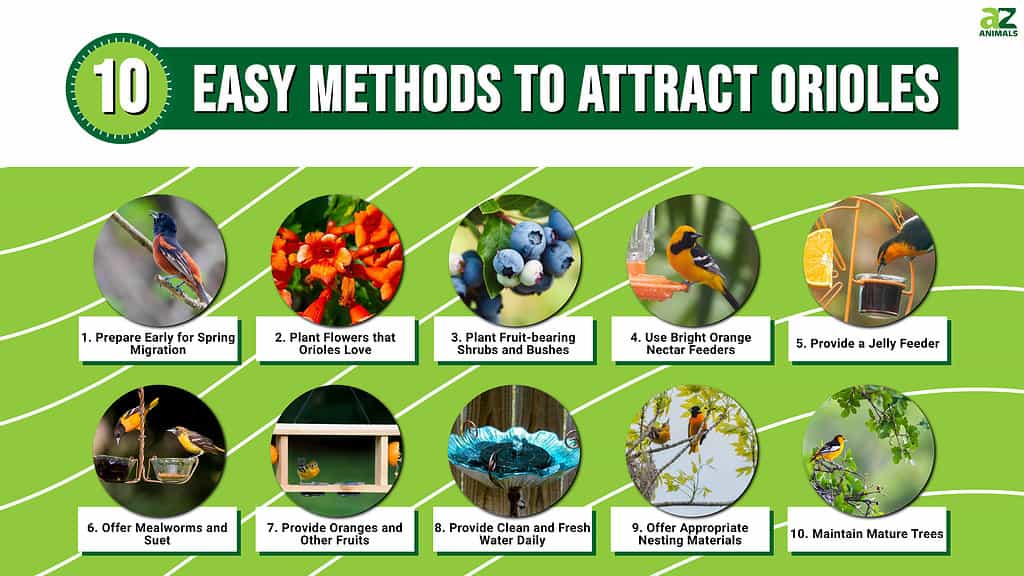
New World orioles belong to the Icteridae family, which includes blackbirds, grackles, meadowlarks, and more. When you think of orioles in the United States, you might immediately picture the familiar Baltimore Oriole, Icterus galbula. But that is not the only oriole species found in North America.
The orioles of the Icterus genus number more than 30 different species, many of which live in South America and Central America all year. However, several oriole species migrate to North America in the summer. The Baltimore Oriole ranges from southern Canada, across the eastern United States, and south through Mexico, Central America and the Caribbean, all the way to Colombia and Venezuela. Other species include Bullock’s Oriole which summers in the western United States and the Orchard Oriole which ranges east of the Rocky Mountains. Scott’s Oriole and the Hooded Oriole range into the southwestern United States, while the Spot-breasted Oriole maintains an introduced population in southern Florida. Both Audubon’s Oriole and the Altamira Oriole have ranges that extend from Mexico into far southern Texas.
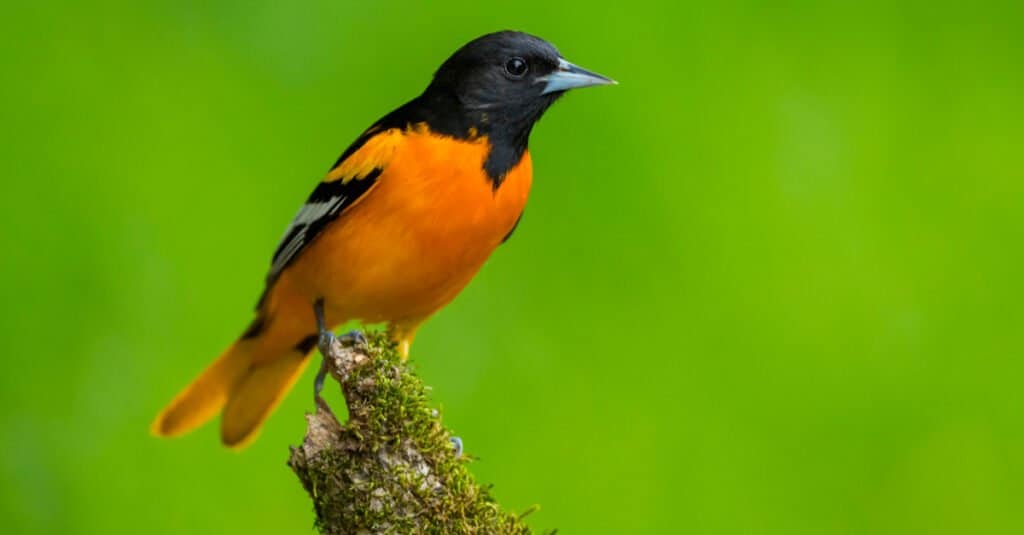
The Baltimore oriole is one of 30 species.
©Agami Photo Agency/Shutterstock.com
How to Attract Orioles: 10 Easy Methods
If you live in an area where orioles range, you might want to attract these colorful songbirds to your yard. Because these birds have somewhat predictable behaviors and are reliably drawn to certain foods, you can attract orioles with a little planning and effort.
1. Prepare Early for Spring Migration

The Orchard Oriole migrates north to the eastern United States and south central Canada.
©iStock.com/Robert Brown
Most of the orioles seen in the United States are migrating songbirds. They do not live in the northern part of their range year-round. They migrate south to Mexico, Central America, or South America during the winter months and return sometime in the spring. In many parts of the United States, local oriole populations return in the spring, toward the end of April. Generally speaking, orioles that spend their summers further south arrive earlier, and those that venture further north arrive later.
If you do not have your feeders out and ready to go before orioles arrive in your area, you are likely to miss attracting them to your yard. Experienced birders recommend preparing your yard for orioles about one week ahead of their expected arrival by decorating your yard with bright orange objects, including feeders that will attract their eyes. You can find out more precisely when to expect orioles in your area by contacting your state department of wildlife, local birding clubs, or even an area bird supply store.
2. Plant Flowers that Orioles Love
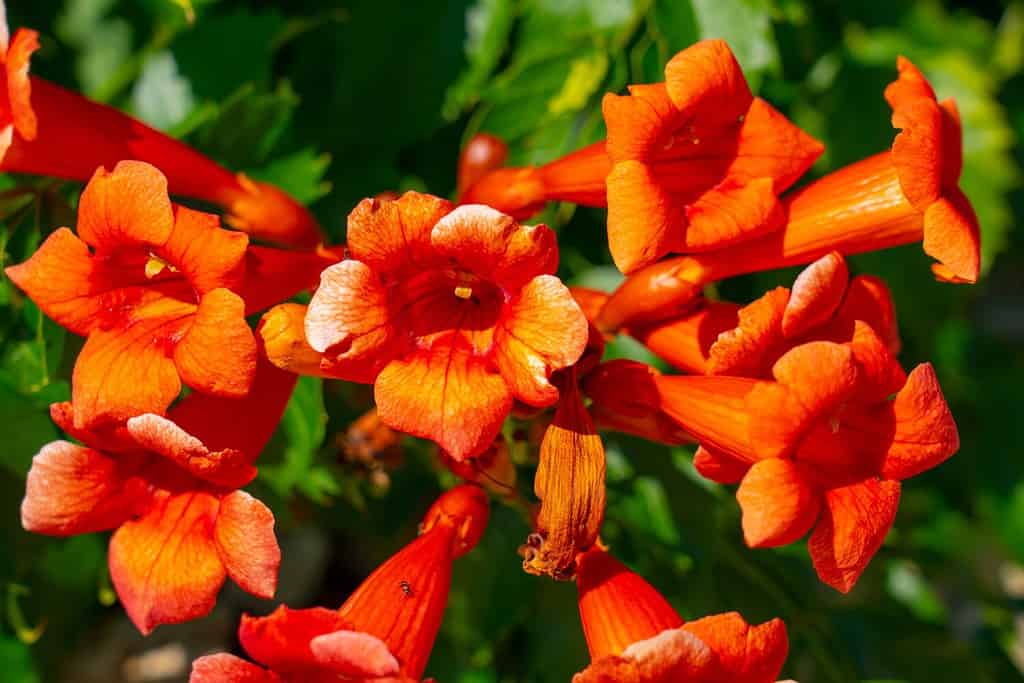
Brightly colored, nectar producing plants like this trumpet vine attract orioles.
©martin.dlugo/Shutterstock.com
Feeding orioles naturally is the best way to attract them to your yard. Fresh, growing flowers provide nectar that they love. Even better, many of the plants that attract orioles are easy to maintain and bloom all summer. Orioles love plants such as coral honeysuckle and trumpet vine. These vining plants look similar, but they belong to different families. Both have abundant bright orange flowers that bloom for months even in the summer heat, and they require little maintenance other than pruning. Other perennials that attract orioles include columbines, monkey flowers, fuchsias, hardy penstemons, and bee balm. Some easy annuals that draw orioles include brightly colored zinnias, petunias, snapdragons, geraniums, and impatiens.
3. Plant Fruit-bearing Shrubs and Bushes

Fruit-bearing bushes and shrubs provide delicious fruit for orioles and other birds.
©iStock.com/Nadya So
Besides nectar, orioles love to eat fruits. One of the easiest ways to provide fruit for birds like orioles is to plant fruit-bearing bushes, shrubs and trees. Serviceberries, also known as Juneberries, provide nectar from abundant, early-blooming flowers along with small fruits that come on later in the spring and summer. Flowering dogwoods and chokecherries also provide an abundance of small, red fruits. Smaller bushes, such as blackberries and raspberries, can begin providing fruit and attracting orioles within one to two years of planting. Blueberry and elderberry bushes will usually produce abundant fruit within about two to three years.
4. Use Bright Orange Nectar Feeders
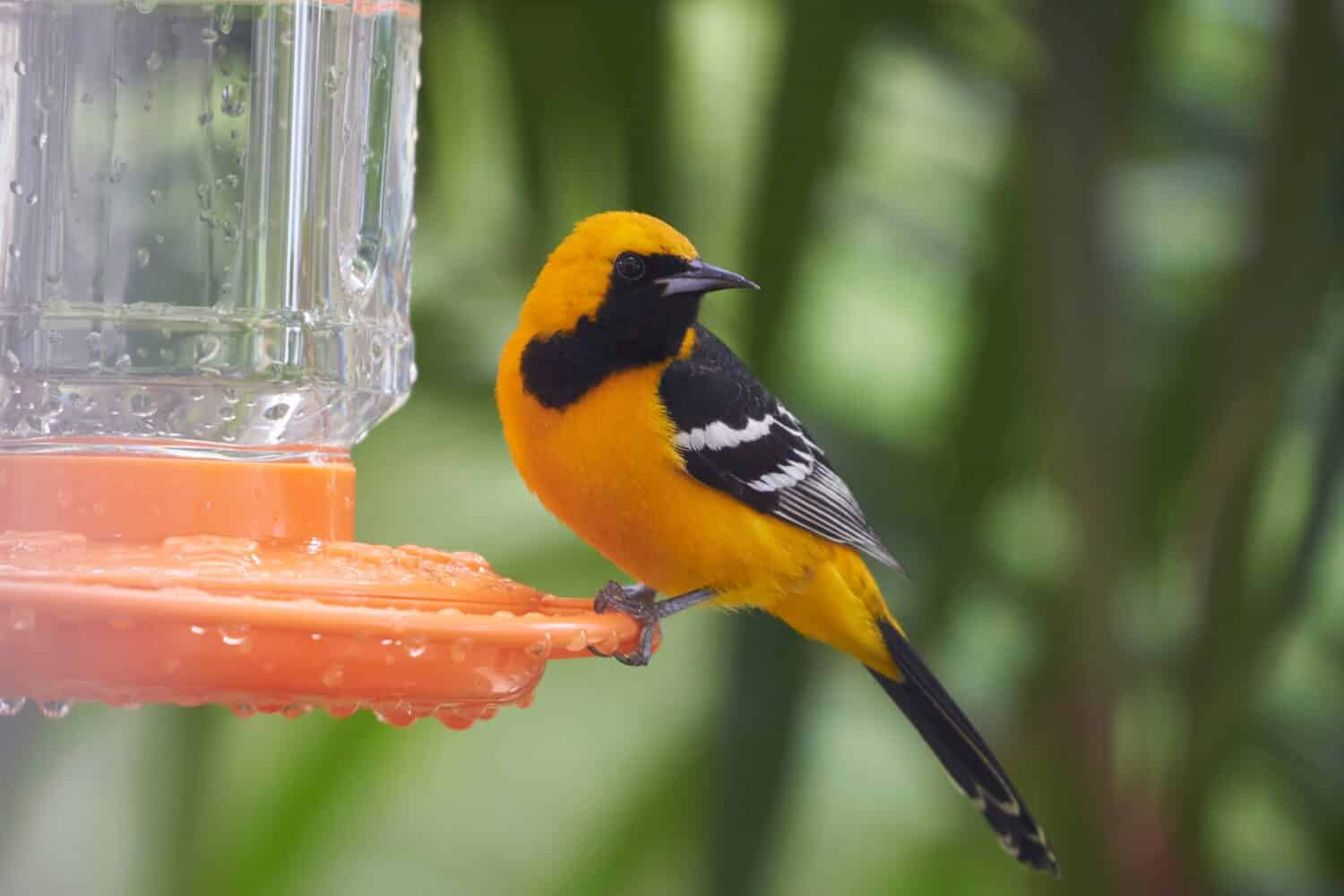
Bright orange feeders provide enough color on their own to attract birds like this Hooded Oriole.
©michael christmas/Shutterstock.com
Anything bright orange in color attracts the attention of orioles. Whereas hummingbirds prefer red feeders, orioles have a strong preference for orange. You can draw even more interest by placing bright orange decorations and ornaments in the vicinity of your feeders.
Orioles will use a variety of different types of feeders. Nectar feeders designed for orioles typically have bright orange bases, and the holes are a bit wider than those of hummingbird feeders. These feeders hang from a hook or a branch and work well with an ant moat, designed to prevent ants from climbing down into them.
Orioles will drink the same water and sugar recipe, in a 4 to 1 ratio, as hummingbirds. However, orioles can also easily tolerate mixtures up to a ratio of 6 to 1, water to sugar. Commercial oriole nectar may be orange or clear, but you do not need to add food coloring to your homemade nectar. The orange color of the feeder base is enough to draw their attention.
Be sure to clean and refill nectar feeders regularly, even if they are not empty. You must do this to prevent the nectar from fermenting in the summer heat and to stop fungus from growing inside the feeders.
5. Provide a Jelly Feeder

Orioles, such as this Bullock’s Oriole, love grape jelly, especially in the spring and early summer.
©J. Omar Hansen/Shutterstock.com
Orioles love grape jelly, along with orange marmalade and other types of jellies and jams. Another type of feeder provides shallow bowls or dishes to fill with tasty treats. Sometimes jelly feeders are combined with nectar feeders or come equipped with a stake for feeding the birds fresh fruit. Some feeders even incorporate all three.
Offering orioles a dish or two of grape jelly provides them with an excellent source of carbohydrates. They need these carbohydrates especially following their long migration in the spring. By late summer, orioles may stop visiting a jelly feeder so often, because their nutritional needs begin to shift in preparation for their migration back to the south.
6. Offer Mealworms and Suet
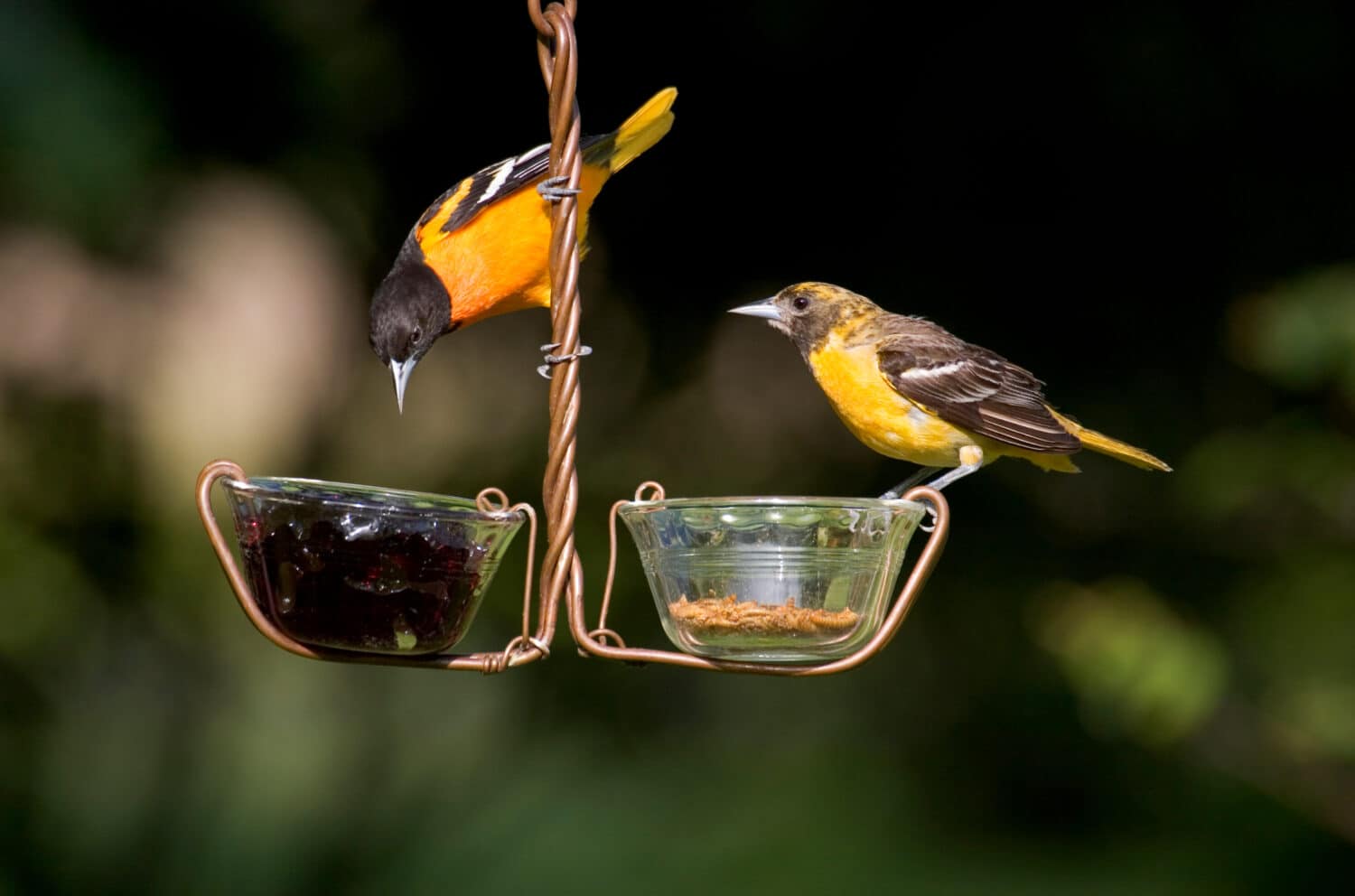
Bowl or dish feeders are a good way to offer both mealworms and jelly.
©Danita Delimont/Shutterstock.com
By the end of the summer, orioles need a lot more protein in their diet. The same bowls or dishes you might have used to provide the birds jelly are a great place to offer mealworms. Suet provides another great source of protein. Orioles are especially drawn to suet that contains berries. Offering these highly desirable treats in or near a bright orange colored feeder increases their visibility and attracts orioles most reliably.
7. Provide Oranges and Other Fruits

Birds like these female Baltimore Orioles are drawn to fresh oranges.
©Danita Delimont/Shutterstock.com
As mentioned above, many feeders also provide a way to offer fresh fruit, such as oranges, a favorite food of orioles. These types of feeders usually incorporate one or more stakes, either alone or in combination with a nectar or cup feeder as described above. Simply cut a fresh orange and place a section on the stake to give visiting orioles one of the foods they love best. Once you attract orioles to your feeders, you can try offering other fruits such as bananas, apples, and peaches. Just make sure to replace the fruit every two to three days to prevent spoilage.
8. Provide Clean and Fresh Water Daily

A bird bath with a bubbler can provide cooler, fresher water for visiting birds.
©Bobbie23/Shutterstock.com
Even though orioles drink a lot of nectar, they still need access to plenty of fresh, clean water. Attracting more orioles and other birds to your yard can be as simple as placing a bird bath or two in your yard, somewhere close to your feeders. A bubbler can help keep the water in the bird bath cooler and fresher, but it still needs to be changed regularly.
9. Offer Appropriate Nesting Materials
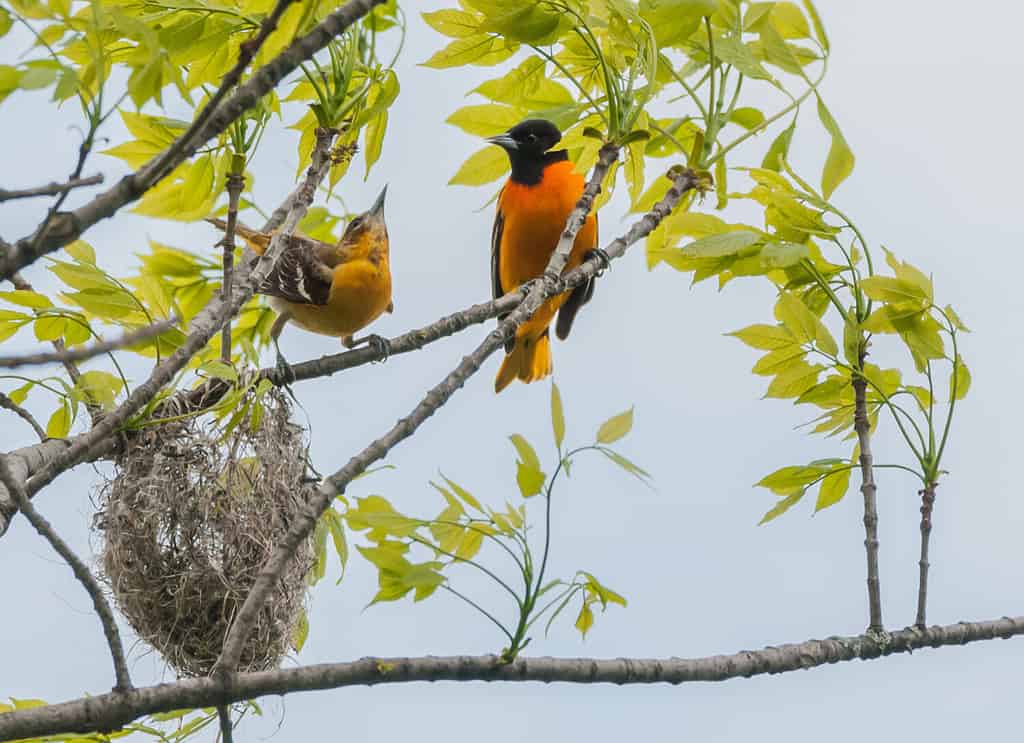
The female oriole weaves a strong, hanging nest from available materials.
©Heather L. Hubbard/Shutterstock.com
Orioles build strong, pouch-shaped nests that hang from the branches of trees. The females weave these nests from materials such as animal hair, long grasses, string, and twine. They line the pouches with even softer material, such as wool, feathers, and the soft inner fibers of plants. Males sometimes help gather these materials.
You can attract orioles and encourage them to nest nearby by providing suitable nesting materials. Put hair, cotton string or yarn, and twine in a suet container and hang it near your feeders to offer orioles materials they can use to weave their nests. Make sure all the materials you offer are natural and biodegradable.
10. Maintain Mature Trees
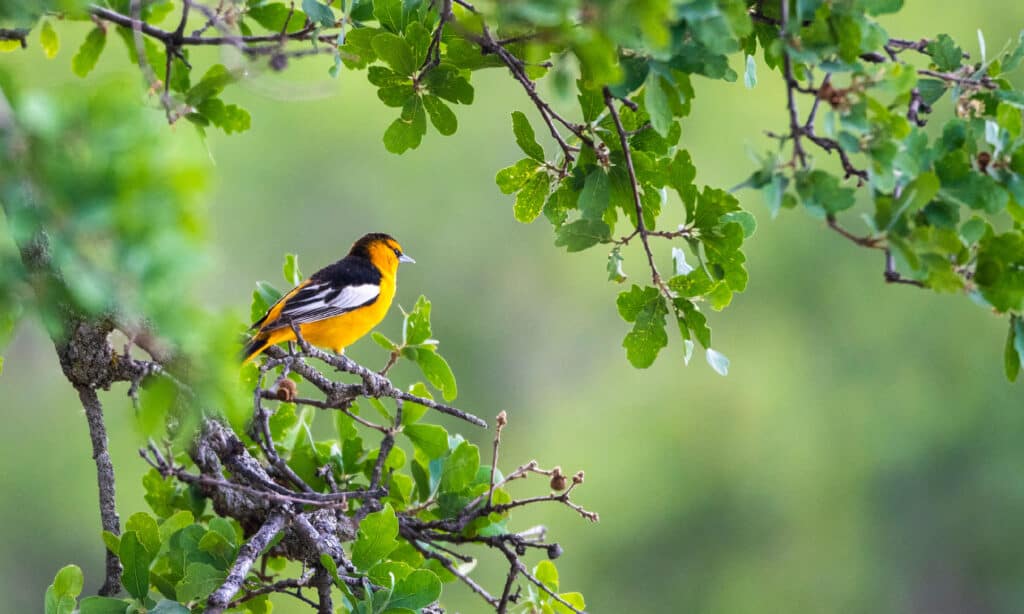
Orioles prefer to nest high in mature trees.
©iStock.com/zhuclear
Orioles prefer to build their nests high in mature trees. Some of the trees they commonly nest in include maples, oaks, sycamores, cottonwoods, and elms. If you want to see orioles returning to your backyard year after year, it is important to provide them with secure places to nest. Of course, growing a large, mature tree where there was none before takes many years. You can certainly plant new trees but also work to maintain the mature trees that already exist nearby. This is the easiest way to make sure orioles and other birds inhabit the area.
Attracting Orioles Takes a Little Bit of Planning
Even if you have never seen one of these beautiful birds in the wild, you can do many things to attract orioles to your yard. Some methods are simple and require only a day or two of preparation. You can order oriole feeders online or pick some up at a local store and be ready to go almost immediately.
Other methods of attracting orioles take more time and planning to execute properly. Planting flowers to bloom in the spring, or bushes to produce berries in another one to three years will improve the quality of your outdoor space and provide food to many types of birds, butterflies, and other creatures. Even if it is too late to attract orioles this year, your efforts will not be wasted. Let’s review some of the methods you can use to attract orioles and support other wildlife, too.
Summary of 10 Tips for Attracting Orioles
| Methods to Attract Orioles | |
|---|---|
| 1 | Prepare early for spring migration. Have feeders ready at least one week ahead. |
| 2 | Plant flowers that orioles love. Brightly colored, nectar-producing flowers are best. |
| 3 | Plant fruit-bearing shrubs and bushes. Any that produce berries are a good choice. |
| 4 | Use bright orange nectar feeders. The nectar itself does not need to be colored. |
| 5 | Provide a jelly feeder. Orioles absolutely love grape jelly and it is a good treat. |
| 6 | Offer mealworms and suet. These high-protein foods are needed by mid-summer. |
| 7 | Provide oranges and other fruits. Fresh fruit should be changed every 2 to 3 days. |
| 8 | Provide clean and fresh water daily. A bubbler can help keep water cool and fresh. |
| 9 | Offer appropriate nesting materials. Try soft things like hair, thread, and twine. |
| 10 | Maintain mature trees in the area. Orioles prefer to nest high in mature trees. |
If Not This Year, Try the Next
Please do not be discouraged if you try everything on this list and still are unable to attract orioles. Remember, most experts say that if you do not catch migrating orioles at the very beginning of the season, you will not likely be able to attract them later in the spring or summer. But there is always next year! Talk to other bird enthusiasts who have been successful at attracting orioles in your area. Find out when they put their feeders out in the spring, and what types of feeders have worked well for them. Get ready early next spring and give it another try.
The photo featured at the top of this post is © michael christmas/Shutterstock.com
Thank you for reading! Have some feedback for us? Contact the AZ Animals editorial team.







